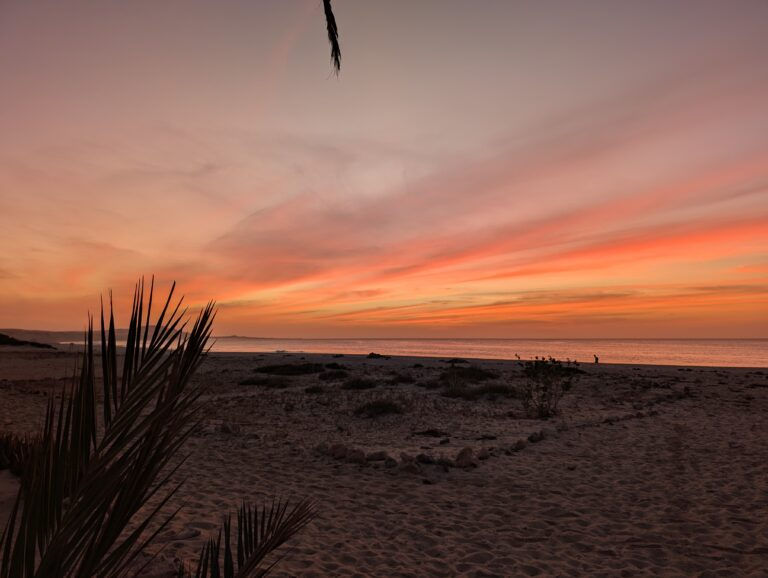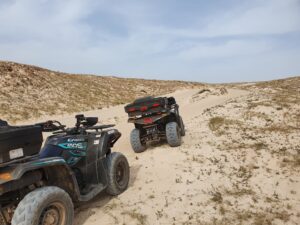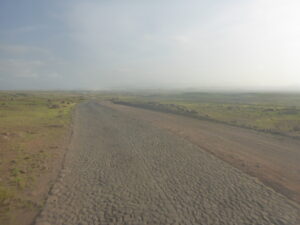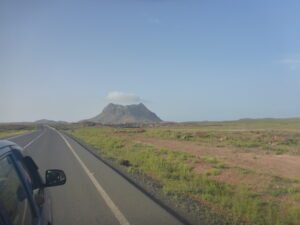Cape Verde – A Background
- Luke Griffiths

- Jul 14
- 6 min read
Updated: Oct 23
We have visited two of the Cape Verde islands multiple times so thought providing a bit of background to the archipelago would be a good idea. You’ll soon be able to read about our adventures on the islands we have visited. There will hopefully be more exploring of this captivating island chain in the future too!
When we first visited the island of Sal in 2014, Cape Verde was relatively unknown as a mainstream destination. I don’t know exactly what it was that had attracted me to them. I’ve never made a secret of my love for small islands, or fishing, or rum. Cape Verde ticks all these boxes!

Cape Verde is made up of 9 populated volcanic islands and is around 1000km south of the Canary islands. From the UK you usually fly over Tenerife to get there and have stunning views of Mount Teide. The Cape Verde islands are how I remember the Canaries from childhood holidays; remote, empty and not very developed. Visiting Cape Verde at first was like stepping back in time, but it is slowly catching up to modern times.

The islands are all different and are divided into two groups. The Barlavento (windward) group contains Santo Antao, Sao Vicente, Sao Nicolau, Boa Vista and Sal as well as the uninhabited island of Santa Luzia. The Sotavento (leeward) group includes Maio, Santiago, Fogo and Brava.
The island of Santiago is home to the capital city of the island – Praia. It is also home to around 300,000 people, over half of the 9 islands’ total population.
Sao Vicente is home to the largest port on the islands, Mindelo. This has been used as a fuelling station since the early 19th century and is part of the reason why the islands have historically been so strategically important. Mindelo is also home to the annual carnival which looks incredible.
The island of Fogo is dominated by an active volcano of the same name. At 2829m above sea level Fogo is around 500m higher than Pico that we struggled up in the Azores. Fogo is the highest point in the Cape Verde archipelago and last erupted in 2014 while we were in Sal. I hoped that the eruption would mean cancelled flights and longer on Sal but unfortunately this wasn’t to be!
Currently, virtually all tourism for the Cape Verdean islands is based on Sal and Boa Vista. The development on Sal has been really dramatic and I do wonder if we would even recognised the place having last visited in 2018.
Santo Antao is green and lush with towering peaks and villages hanging onto the side of mountains.

Maio has an amazing mix of beaches and forests. The forest almost seems like it is out of place on a desert island. I’d love to visit Maio myself soon.
While the islands may appear to be just specks in the ocean they are all filled with life, including several endemic species. We have visited Boa Vista ‘after the rain’. It’s amazing to see how plant life just appears in once barren areas even with the small amount of rain received.
Donkeys are common on most islands, as are cats, dogs and goats. You can sometimes see the occasional cow too but these are less common. The islands of Santiago and Brava are home to green monkeys.

The seas around the islands are full of life. It is incredible to see humpback whales and their calves playing in the water in February/March. Sometimes they are even visible from the beaches! Turtles visit some of the islands over the summer to nest, and it is even possible to see them at other times of year swimming by the shore. We’ve been lucky enough to share fishing spots with inquisitive turtles a few times!

The Viana desert in the middle of Boa Vista is small but amazing. The most interesting thing about it is the journey that the sand has been on. The dunes are formed by sand that has blown across the ocean from the Sahara. The majority of this sand is blown across the Atlantic and feeds the Amazon rainforest but enough of it is caught by Boa Vista to sustain a desert.

When the skies above islands are not filled by transatlantic sand they are a great place for stargazing. I have often found myself distracted from watching my rod when night fishing by the light show going on above my head. When we visited in 2024 I was on the beach as a train of Starlink satellites that had just been launched passed overhead – this was quite a sight!

Cape Verde is home to a number of interesting bird species. Until recently this included the magnificent frigatebird that had a wingspan of nearly 2.5 meters. These were last seen on Boa Vista in 2016 so unfortunately may not still be there. There is a healthy population of ospreys as well as brown boobies – both of which are better at fishing than I am. I get distracted (again!) by the swooping birds while fishing. Seeing an osprey surface with its prey is one of my favourite memories of Boa Vista.
Cape Verde gained its independence on 5th July 1975 having previously been a Portuguese territory. The islands were discovered by Europeans during the mid-1400s and taken over by the Portuguese in 1461. Cape Verde is thought to be the first ever European overseas colony.
Their location made the islands an ideal staging post for exploring the world and they were an intrinsic part of Portugal’s role in the international slave trade. Mindelo on the island of Sao Vicente was a hugely important port for ships circumnavigating the continent of Africa via the Cape of Good Hope. This importance waned with the opening of the Suez Canal in the 1860s.
The people are a big part of what makes Cape Verde special. The islands lie between Africa and the Caribbean, and while the people may be a mix of African and European there is a distinct Caribbean edge to them. This shows in the music and dancing which wouldn’t be out of place anywhere in the Caribbean or in Brazil. The warmth, friendliness and work ethic of the Cape Verdean people is great to see and makes spending time with them a pleasure.
Senegal is the closest African country and there are an increasing number of Senegalese people on some of the islands. The opportunities that tourism provides draws them in and it is interesting to see how they integrate with the local population. It will also be interesting to see how much of a viable option staying in Cape Verde is now that Senegal has its own growing tourism sector.
Portuguese and Creole are the main languages spoken on the islands. With the rise of tourism it isn’t unusual to meet locals who are fluent in multiple languages. It is actually really noticeable how much improvement there has been in speaking English from our first visit to Cape Verde until now. In this time my Portuguese has stayed at exactly the same 5 words. We have recently met locals who speak 5, 6 or 7 languages fluently, as well as having basic knowledge of others – incredible!
Cape Verde is a 6 hour direct flight from the UK, and the timezone is UTC-1 which means it is close enough to the time in the UK to not cause any jet lag. They use standard European 2 pin plugs and drive on the right. A lot of the roads aren’t roads at all – the cobbled tracks turn into dust tracks, then back into cobbles! Where there are tarmac roads they are some of the best and smoothest we’ve ever driven on.
The weather is relatively stable all year round with temperatures between 25 and 30°C. The wind does change seasonally and there is also a wetter part of the year. The months of August to October contribute more than half of the annual rainfall total. Some of the storms that hit the islands at this time of year go on to cross the Atlantic and develop into hurricanes as they meet the warm water of the Caribbean sea/Gulf of Mexico.
I have long found it a tricky balance to show my affection for the islands while not encouraging too many people to visit them. It is the desolation and emptiness of Boa Vista that I appreciate so much and if everyone knew how amazing it was then it would soon not be so empty and unspoilt! The islands need responsible tourism though and telling other people about them is the way to help with that.
The estimates for the average wage vary but it is thought to be somewhere between £2000 and £3000 a year. For people not lucky enough to be involved in tourism (and even for some who are) life can be a struggle. We have donated items and even encouraged our friends to do the same in order to try to make life a little bit better but more is needed. If you are looking for a destination to visit where you feel safe and welcomed then I would recommend Cape Verde. If you can take some additional items that you can leave these will make a huge difference to the locals.























Comments